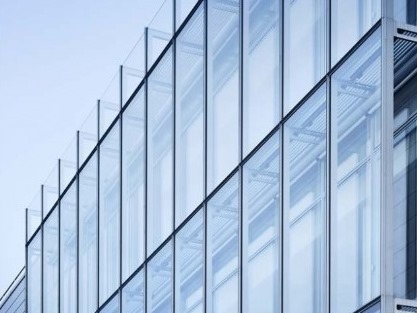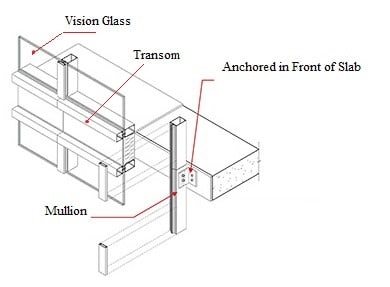Types of Curtain Wall System – its Details, Functions and Advantages
Curtain wall system comprises one of the elements of facade technology in high rise building. Facades involves window wall, cladding elements and curtain walls which generates the exterior envelope of the building.
The curtain wall systems now possess structural importance equivalent to that gained by other structural elements of the building. As it has a higher exposure to exterior atmosphere, it has to be properly designed, installed and maintained keeping in mind the functionality and sustainability.

Fig.1: Curtain Wall System

Fig.2: Curtain Wall Construction
Functions of Curtain Walls in Buildings
Elimination of Water Penetration
Water penetration is the fundamental function of a facade. Here bringing a completely impermeable sealed curtain panel system is not possible. Hence two stages of prevention are placed. Primary level where complete defense of water is conducted and if that fails a secondary level where a direction to let percolated water to drained out has to be provided.
Air impermeability
This function is more of an environment concern to reduce the emission of carbon dioxide due to rate of heat loss or gain within the external and internal environment.
Resistance to wind, thermal and acoustic action
Wind actions are transferred by the cladding system to the building floors which act as a linear support. Building cladding systems formed of large panels are usually one-way spanning. Each floor level therefore supports one level of wind load on a building.
Thermal insulation function which is strictly necessary for a facade in order to reduce energy consumption and CO2 emissions. Insulated materials are provided to both opaque as well as transparent areas.
Acoustic Insulation too is necessary between the inside and the outside environment mainly city centered building. Massive structural elements possess higher acoustic insulation like masonry or concrete structures.
Solar levels
This can be reduced by providing a selective solar control coating on one of the surfaces of the glass. This coating is called selective because solar radiation of different wavelengths is selectively allowed to pass through the coating: visible wavelengths of light are allowed to pass more freely than infrared wavelengths. For example, spaces for exhibitions or displays of materials can undergo degradation due to ultraviolet radiation. For this a UV-inhibiting film can be applied to the surface of glazing.
Types of Curtain Wall System
Curtain wall systems are factory pre casted systems. They are bought to the site and assembled. These are of two types based on the way each component is assembled.
Stick Curtain Wall System involves its components to be assembled piece by piece on the building at the site. These are mainly installed in low rise building or small regions. This is because, to reach higher elevations exterior access is essential. For this additional requirements like scaffolding, cranes etc. will be required.
The above system gains the advantage of low shipping cost as onsite adjustments are possible. But the time and labor consumption is recorded to be high.
Unitized curtain wall systems involves assembling by means of interlocking units that are bought from the factory. The whole components are bought together as a single unit from the factory. Individual installation of each component are not necessary as in sticky curtain wall system. The size of the unitized curtain walls are dependent on the floor to floor height of the building. Hence it is essential to keep in mind the mode of transportation and installation while planning the depth of facade. This system is mainly used in high rise building. This does not require exterior supports like cranes or scaffolding. Only mini cranes or a temporary hoist can be held over floor to keep it help during installation.
This system gains advantage of faster construction and higher quality because of factory manufacturing. But it gains high shipping charge as mentioned due to requirement of larger protection during transportation.
Components of a Curtain Wall
The complete unit consist of the following structural elements
- Transom
- Mullions
- Vision Glass
- Anchor

Fig.3: Detailed Components of a Curtain Wall System

Fig.4: Mullions and Transoms
Transom or horizontal rails are horizontal members on the curtain wall panel. The mullions or vertical rails are anchored to the edge slab or beam. These are mainly involved in supporting the dead weight of the curtain wall. In conventional or sticky curtain wall system each system has to be placed one after the other. High quality check and precision in required for the installation. But in unitized system the factory product comes as two units alone which has to connected.
Panel Framing details of Curtain Walls
Unitized system is identified by the split mullions and the transforms that are evident in the panel perimeters as shown in figure.5.

Fig.5: Unitized Curtain Wall
In case of sticky curtain wall, there is no sort of splits all forms a single unit. During Longer spans, there will be a need for intermediate transom which would essentially split the entire vertical panel into two.
In order to prevent condensation, mullions and transom are thermally broken. This prevents cold bridging.
Weather Tightness of Curtain Walls
The weather tightness mainly deals with the issue of water permeability. In order to avoid this impermeable insulating units (glazed units) are employed. In addition to which a gasket is provided which leads to a rebate. Any water that moves into the gasket is lead to the rebate which in turn is drained out through the transom joints or mullions ends.
Support Conditions of Curtain Walls
As discussed curtain wall systems are hung from top which are laterally supported at different floor levels. Most of the supports are held at the edge beams. Hence it is essential to have a highly stiffened edge beam in order to avoid larger deflections.
These vertical deflections could disturb the whole curtain system. So proper edge beam provision would prevent damage to the curtain wall and cladding system particularly when it is highly glazed.
As an alternative steel strong backs can be provided so that they can span between the perimeter columns and hence it is not necessary to connect to the edge beams or floor slabs. The strong backs are mainly hot rolled sections.
Structural Behavior of Curtain Walls
Past studies have showed that curtain walls seem to be resistant against lateral forces mainly earthquake, but there is measurable amount of damage caused. Even though damage can be repaired, there is economy loss and delay in business activity.
Curtain walls are considered as structural elements of a building. As it acts as a partition between exterior and interior environment of the building, it has a role in transmission of loads acting for structural stability.
It transmits wind induced loads to the primary structure. It also resists the seismic accelerations keeping the occupants comfortable. Other than this it has to resist gravity loads coming over it.
When considering the durability of the building, curtain walls play an efficient role in adapting to different temperature ranges. This is because of the case in high rise building, as the number of floors the temperature seems high and would be a risk factor for the occupants working in those floors. It is also required to have resistance against water penetration and hence stop corrosion.
No comments:
Post a Comment